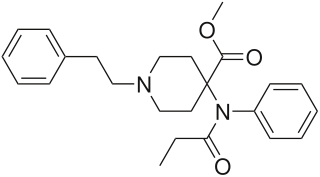
Fentanyl, also spelled fentanil, is a highly potent synthetic piperidine opioid drug primarily used as an analgesic. Because fentanyl is 50 to 100 times more potent than morphine, its primary clinical utility is in pain management for cancer patients and those recovering from painful surgical operations. Fentanyl is also used as a sedative. Depending on the method of delivery, fentanyl can be very fast acting and ingesting a relatively small quantity can cause overdose. Fentanyl works by activating μ-opioid receptors. Fentanyl is also commonly known as fentanyl citrate and is sold under the brand name Sublimaze, among others.

Carfentanil or carfentanyl, sold under the brand name Wildnil, is an extremely potent opioid analgesic which is used in veterinary medicine to anesthetize large animals such as elephants and rhinoceroses. It is typically administered in this context by tranquilizer dart. Carfentanil has also been used in humans for imaging of opioid receptors. It has additionally been used as a recreational drug, typically by injection, insufflation, or inhalation. Deaths have been reported in association with carfentanil.

Sufentanil, sold under the brand names Dsuvia and Sufenta, is a synthetic opioid analgesic drug approximately 5 to 10 times as potent as its parent drug, fentanyl, and 500 times as potent as morphine. Structurally, sufentanil differs from fentanyl through the addition of a methoxymethyl group on the piperidine ring, and the replacement of the phenyl ring by thiophene. Sufentanil first was synthesized at Janssen Pharmaceutica in 1974.

Remifentanil, marketed under the brand name Ultiva is a potent, short-acting synthetic opioid analgesic drug. It is given to patients during surgery to relieve pain and as an adjunct to an anaesthetic. Remifentanil is used for sedation as well as combined with other medications for use in general anesthesia. The use of remifentanil has made possible the use of high-dose opioid and low-dose hypnotic anesthesia, due to synergism between remifentanil and various hypnotic drugs and volatile anesthetics.

Piritramide(R-3365, trade names Dipidolor, Piridolan, Pirium and others) is a synthetic opioid analgesic that is marketed in certain European countries including: Austria, Belgium, Czech Republic, Slovenia, Germany and the Netherlands. It comes in free form, is about 0.75x times as potent as morphine and is given parenterally for the treatment of severe pain. Nausea, vomiting, respiratory depression and constipation are believed to be less frequent with piritramide than with morphine, and it produces more rapid-onset analgesia when compared to morphine and pethidine. After intravenous administration the onset of analgesia is as little as 1–2 minutes, which may be related to its great lipophilicity. The analgesic and sedative effects of piritramide are believed to be potentiated with phenothiazines and its emetic (nausea/vomiting-inducing) effects are suppressed. The volume of distribution is 0.7-1 L/kg after a single dose, 4.7-6 L/kg after steady-state concentrations are achieved and up to 11.1 L/kg after prolonged dosing.

α-Methylacetylfentanyl is an opioid analgesic that is an analog of fentanyl. It is a Schedule I controlled substance in the United States, with a DEA ACSCN of 9815.

Parafluorofentanyl is an opioid analgesic analogue of fentanyl developed by Janssen Pharmaceuticals in the 1960s.

Betahydroxythiofentanyl (β-hydroxythiofentanyl) is an opioid analgesic that is an analog of fentanyl. Beginning as early as 2008, clandestine labs in China began to manufacture synthetic opioids on an industrial scale. Initially, these opioids were distributed in Eastern European markets such as Ukraine and Estonia. Beginning in 2015, fentanyl had replaced heroin as the opioid of choice due to its cheap cost of production and astronomical potency. Utilizing loosely regulated drug laws in the ports of western Mexico, Mexican and Chinese criminal organizations began to traffic the drug en masse along the U.S.-Mexico border.

β-Hydroxyfentanyl (Fentanol) is an opioid analgesic that is an analogue of fentanyl.

Trefentanil (A-3665) is an opioid analgesic that is an analogue of fentanyl and was developed in 1992.

Brifentanil (A-3331) is an opioid analgesic that is an analogue of fentanyl and was developed in the early 1990s.

Lofentanil or lofentanyl is one of the most potent opioid analgesics known and is an analogue of fentanyl, which was developed in 1960. It is most similar to the highly potent opioid carfentanil (4-carbomethoxyfentanyl), only slightly more potent. Lofentanil can be described as 3-methylcarfentanil, or 3-methyl-4-carbomethoxyfentanyl. While 3-methylfentanyl is considerably more potent than fentanyl itself, lofentanil is only slightly stronger than carfentanil. This suggests that substitution at both the 3 and 4 positions of the piperidine ring introduces steric hindrance which prevents μ-opioid affinity from increasing much further. As with other 3-substituted fentanyl derivatives such as ohmefentanyl, the stereoisomerism of lofentanil is very important, with some stereoisomers being much more potent than others.

3-Allylfentanyl is an opioid analgesic that is an analogue of fentanyl.

Ocfentanil is a potent synthetic opioid structurally related to fentanyl that was developed in the early 1990s as one of a series of potent naloxone-reversible opioids in an attempt to obtain an opioid that had better therapeutic indices in terms of cardiovascular effects and respiratory depression as compared to fentanyl. Ocfentanil was never developed for medical use despite reasonable results in human clinical trials, but subsequently started to be sold as a designer drug starting in around 2013.

4-Phenylfentanyl is an opioid analgesic that is a derivative of fentanyl. It was developed during the course of research that ultimately resulted in super-potent opioid derivatives such as carfentanil, though it is a substantially less potent analogue. 4-Phenylfentanyl is around eight times the potency of fentanyl in analgesic tests on animals, but more complex 4-heteroaryl derivatives such as substituted thiophenes and thiazoles are more potent still, as they are closer bioisosteres to the 4-carbomethoxy group of carfentanil.

Butyrfentanyl or butyrylfentanyl is a potent short-acting synthetic opioid analgesic drug. It is an analog of fentanyl with around one quarter of its potency. One of the first mentions of this drug can be found in document written by The College on Problem of Drug Dependence, where it is mentioned as N-butyramide fentanyl analog. This document also states that the article describing its clinical effects was published in 1987. It is an agonist for the μ-opioid receptors.

4-Fluorobutyrylfentanyl (also known as 4-FBF and p-FBF or para-fluorobutyrylfentanyl) is an opioid analgesic that is an analog of butyrfentanyl and has been sold online as a designer drug. It is closely related to 4-fluorofentanyl, which has an EC50 value of 4.2 nM for the human μ-opioid receptor.

Acrylfentanyl (also known as acryloylfentanyl or Egyptenyl) is a highly potent opioid analgesic that is an analog of fentanyl and has been sold online as a designer drug. In animal studies the IC50 or half maximal inhibitory concentration for acrylfentanyl to displace naloxone is 1.4 nM, being slightly more potent than fentanyl itself (1.6 nM) as well as having a longer duration of action.

Thiafentanil is a highly potent opioid analgesic that is an analog of fentanyl, and was invented in 1986. Its analgesic potency is slightly less than that of carfentanil, though with a faster onset of effects, shorter duration of action and a slightly lesser tendency to produce respiratory depression. It is used in veterinary medicine to anesthetise animals such as impala, usually in combination with other anesthetics such as ketamine, xylazine or medetomidine to reduce the prevalence of side effects such as muscle rigidity.

Tetramethylcyclopropylfentanyl is an opioid analgesic that is an analog of fentanyl and has been sold as a designer drug.





















